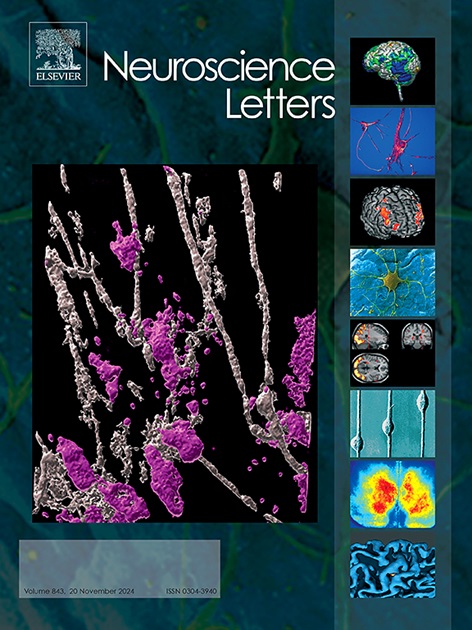The expression of connexin 36 and 43 in animal models of trait and state anxiety
IF 2
4区 医学
Q3 NEUROSCIENCES
引用次数: 0
Abstract
Few studies have investigated the role of gap junctions in anxiety. Gap junctions (GJs) are intercellular channels, and their subunit are connexins (CXs). The specific isoforms of connexins for neurons and astrocytes are CX36, and CX43 respectively. Neuronal CX36 and astrocytic CX43 are critical for brain synchrony and homeostasis. Elevated plus maze (EPM) was used for animal models of trait and state anxiety. The gene expression was assessed by Real-time PCR technique in the ventral hippocampus (v Hip), basolateral amygdala (BLA), and medial prefrontal cortex (m PC). The rats were grouped as follows (n = 6): control, trait anxiety, in which the rats were placed in the EPM apparatus, state anxiety, in which the animals were placed in the EPM apparatus after tolerating 120 min of isolation. The data showed that the anxiety of the animals in the state anxiety group was significantly greater than the trait anxiety group (p < 0.05). In the state anxiety animals, the gene expression of CX36 was lower in the m PC and BLA regions than the control and trait anxiety groups (p < 0.01). CX43 expression in the BLA, and v Hip structures was also lower than in the control and trait anxiety groups. These findings suggest that downregulation of CX36 and CX43 contributes to state anxiety pathophysiology, highlighting GJs as potential therapeutic targets.
连接蛋白36和43在特质性和状态性焦虑动物模型中的表达。
很少有研究调查间隙连接在焦虑中的作用。间隙连接(GJs)是细胞间通道,其亚基是连接蛋白(CXs)。神经元和星形胶质细胞连接蛋白的特异性同工型分别为CX36和CX43。神经元CX36和星形细胞CX43对大脑同步和体内平衡至关重要。采用升高+迷宫(EPM)方法建立动物模型。采用Real-time PCR技术检测海马腹侧区(v Hip)、杏仁核基底外侧区(BLA)和内侧前额叶皮质区(m PC)的基因表达。将大鼠分为两组(n = 6):对照组,特质焦虑组,置于EPM仪中;状态焦虑组,在隔离120 min后,置于EPM仪中。数据显示,状态焦虑组动物的焦虑显著大于特质焦虑组(p
本文章由计算机程序翻译,如有差异,请以英文原文为准。
求助全文
约1分钟内获得全文
求助全文
来源期刊

Neuroscience Letters
医学-神经科学
CiteScore
5.20
自引率
0.00%
发文量
408
审稿时长
50 days
期刊介绍:
Neuroscience Letters is devoted to the rapid publication of short, high-quality papers of interest to the broad community of neuroscientists. Only papers which will make a significant addition to the literature in the field will be published. Papers in all areas of neuroscience - molecular, cellular, developmental, systems, behavioral and cognitive, as well as computational - will be considered for publication. Submission of laboratory investigations that shed light on disease mechanisms is encouraged. Special Issues, edited by Guest Editors to cover new and rapidly-moving areas, will include invited mini-reviews. Occasional mini-reviews in especially timely areas will be considered for publication, without invitation, outside of Special Issues; these un-solicited mini-reviews can be submitted without invitation but must be of very high quality. Clinical studies will also be published if they provide new information about organization or actions of the nervous system, or provide new insights into the neurobiology of disease. NSL does not publish case reports.
 求助内容:
求助内容: 应助结果提醒方式:
应助结果提醒方式:


